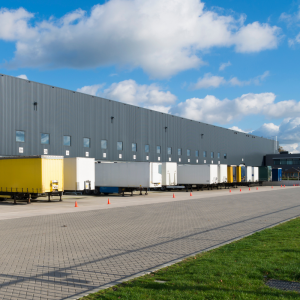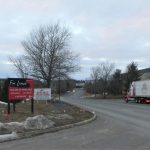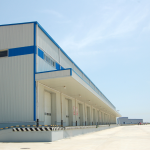New Jersey Future Blog
Environmental Justice and Warehouse Sprawl
December 7th, 2021 by Tim Evans
Earlier this year, New Jersey Future released a report about the growth of warehousing in New Jersey, and that growth pressure has only grown more intense in the intervening months. The report focused mainly on the use—and in many cases, the re-use—of land for warehouse development and its impact on host communities in terms of land consumption. The report mentioned, but did not explore in as much detail, the other major negative impact of warehouses: truck traffic. This is a particular concern for areas near the port, where residents have historically experienced a variety of environmental stressors, the legacy of New Jersey’s industrial past.
The desire to prevent truck traffic is a major factor contributing to neighboring residents’ objections to warehouse development, no matter where that development happens. Warehouses attract trucks, and the bigger the warehouse facility, the more or bigger the trucks that drop off or pick up shipments there. In outlying areas near the highway interchanges that are attractive to industrial developers, it is often the case that the local roads were not designed to handle the size and volume of trucks that large distribution facilities will attract.
In neighborhoods in the urban core that are closer to the port itself—and which are therefore even more attractive to the goods movement industry—the problem is more insidious. Here, on top of their contribution to congested roads, the air and noise pollution from trucks is just one of a myriad of environmental hazards that these communities have historically faced, based on past decisions about the siting of various noxious land uses. If port-dependent warehouse facilities are best located near the port itself from a logistical standpoint, how does one guard against further burdening adjacent neighborhoods with additional negative environmental impacts?
The recently passed environmental justice bill (S232) may seem a logical place to look for a solution. But, the law only explicitly targets eight specific land-use types (like incinerators, power plants, or waste-processing facilities) that can be thought of as point-source polluters. In these cases, the function of the site itself produces or emits environmental stressors that degrade air or water quality in the surrounding area. The law was designed to prevent the siting of such facilities in areas that have been historically—and disproportionately— burdened by environmental hazards.

Photo Credit: Canva
Warehouses are not point-source polluters themselves; that is, the on-site functions of storing and sorting merchandise do not inherently generate pollution to the point that they warrant regulatory oversight. Instead, warehouses attract a steady stream of mobile sources of pollution (i.e., trucks). As such, the environmental justice law does not directly apply to warehouses.
The Murphy administration has made environmental justice a priority, pledging to end the siting of environmental hazards in neighborhoods where low-income people and/or people of color live—and especially neighborhoods that are characterized by the presence of both low-income households and people of color. The New Jersey Department of Environmental Protection (NJDEP) has created and now maintains a list of overburdened communities and is charged with ensuring that state agency actions do not result in the siting of additional noxious land uses in these neighborhoods. If the NJDEP lacks direct authority to regulate warehouses from an air-quality perspective, how else might the State bring environmental justice considerations to bear in decisions about where to site warehouses?
One promising avenue is the involvement of the State Planning Commission (SPC). New Jersey Future has already advocated for having the SPC and its staff at the Office of Planning Advocacy prepare a statewide warehousing plan, which would be tasked with identifying appropriate sites for large warehouse developments based on multiple considerations, including the effects on host communities. In addition to the reasons cited in our earlier comments, involving the SPC could be a means by which to introduce environmental justice considerations into siting decisions. A warehouse development plan could, for example, examine the truck travel routes that are and should be taken to minimize harm to communities. It could explicitly include among its criteria the likely effects of warehouse development on overburdened communities in a way that the NJDEP is not presently empowered to do.
The State’s push toward vehicle electrification is another leverage point. The administration’s blueprint for cutting back the state’s carbon footprint, the Global Warming Response Act 80×50 Report, has placed a strong emphasis on vehicle electrification. Trucks are unavoidable in the goods movement industry, and if warehousing continues to locate near the port, trucks will remain a fixture on the adjacent highway network. But, they don’t have to be mobile sources of air pollution. To this end, the various state agency programs aimed at electrifying the vehicle fleet should place a priority on heavy trucks rather than on constructing charging stations for private electric vehicles in upscale suburban neighborhoods.
Environmental Justice communities have been confronting the negative impacts of freight movement for years, and organizations aligned with these interests have been elevating this issue and championing solutions for more than a decade. With the addition of statewide warehouse sprawl to the freight movement and warehousing discussion, a new set of land-use, community, and economic issues have been brought to the foreground. It is important to link the issue of warehouse sprawl with environmental justice issues to develop solutions that are good for communities, the environment, and the economy and to do so in a way that corrects past—and ongoing—injustices.
A short list of old and new recommendations:
- Elevate medium- and heavy-duty vehicles to the top of the priority list for vehicle electrification and deploy them first in overburdened communities. New Jersey should continue to pursue its own version of California’s Advanced Clean Trucks rule and should also continue its existing incentive programs to encourage and assist businesses and institutions in acquiring zero-emissions trucks.
- Prioritize the electrification of the port itself, including on-site equipment and yard tractors, in addition to the over-the-road trucks that pick up or deposit freight there. The recent introduction of the first batch of electric yard goats is a first step in this direction.
- Assign to the SPC and its staff at the Office of Planning Advocacy the task of developing a statewide warehousing plan, the purpose of which is to identify the most appropriate sites for future warehouse development. The plan would establish criteria for identifying these sites, and these criteria should include the likely effects of emissions from heavy trucks on host communities. The SPC should recommend against siting new warehouse developments in environmental justice communities if they are projected to worsen air quality there, using criteria similar to those outlined in S232 regarding the NJDEP’s authority to deny permits to point-source facilities.
Related Posts
Tags: Development, sprawl, warehouse sprawl, warehousing
















